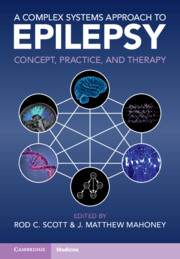Book contents
- A Complex Systems Approach to Epilepsy
- A Complex Systems Approach to Epilepsy
- Copyright page
- Contents
- Contributors
- Chapter 1 Introduction
- Chapter 2 Systems Biology Approaches to the Genetic Complexity of Epilepsy
- Chapter 3 Transcriptomic and Epigenomic Approaches for Epilepsy
- Chapter 4 Phenomenological Mesoscopic Models for Seizure Activity
- Chapter 5 Personalized Network Modeling in Epilepsy
- Chapter 6 The Baseline and Epileptiform EEG
- Chapter 7 Neuronal Approaches to Epilepsy
- Chapter 8 Mapping Epileptic Networks with Scalp and Invasive EEG
- Chapter 9 A Neuroimaging Network-Level Approach to Drug-Resistant Epilepsy
- Chapter 10 Epilepsy as a Complex Network Disorder
- Index
- References
Chapter 5 - Personalized Network Modeling in Epilepsy
Published online by Cambridge University Press: 06 January 2023
- A Complex Systems Approach to Epilepsy
- A Complex Systems Approach to Epilepsy
- Copyright page
- Contents
- Contributors
- Chapter 1 Introduction
- Chapter 2 Systems Biology Approaches to the Genetic Complexity of Epilepsy
- Chapter 3 Transcriptomic and Epigenomic Approaches for Epilepsy
- Chapter 4 Phenomenological Mesoscopic Models for Seizure Activity
- Chapter 5 Personalized Network Modeling in Epilepsy
- Chapter 6 The Baseline and Epileptiform EEG
- Chapter 7 Neuronal Approaches to Epilepsy
- Chapter 8 Mapping Epileptic Networks with Scalp and Invasive EEG
- Chapter 9 A Neuroimaging Network-Level Approach to Drug-Resistant Epilepsy
- Chapter 10 Epilepsy as a Complex Network Disorder
- Index
- References
Summary
Epilepsy is a family of neurological disorders in which patients experience unprovoked spontaneous seizures. Unfortunately, there is currently no cure for epilepsy, and seizure management is the target of most therapies. The first-line treatment of epilepsy is usually antiepileptic drugs. However, depending on the subtype of epilepsy and the individual, drug treatments fail to control the seizures in around one-third of patients. One challenge in the treatment of epilepsy is its heterogeneity. In each patient, seizures are thought to be generated by different mechanisms, processes, and parameters, and treatment outcomes will also depend on these.
Information
- Type
- Chapter
- Information
- A Complex Systems Approach to EpilepsyConcept, Practice, and Therapy, pp. 61 - 71Publisher: Cambridge University PressPrint publication year: 2023
